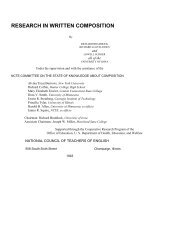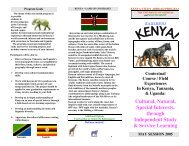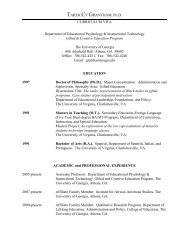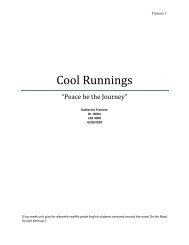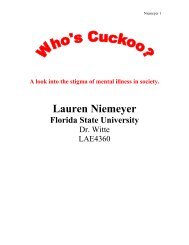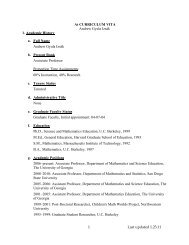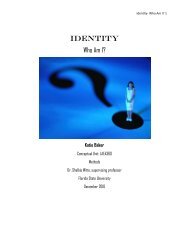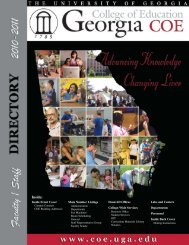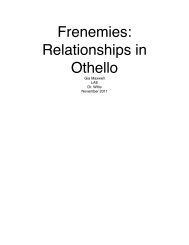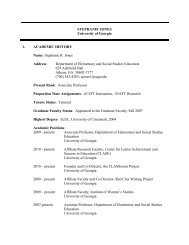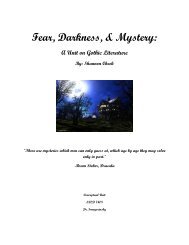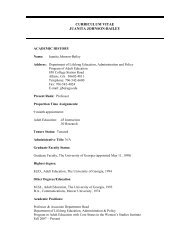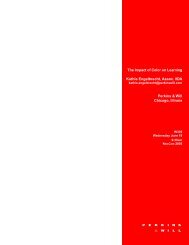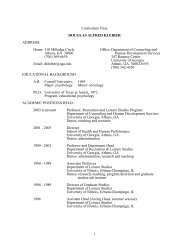Elie Wiesel's Night: Out of the Darkness - College of Education
Elie Wiesel's Night: Out of the Darkness - College of Education
Elie Wiesel's Night: Out of the Darkness - College of Education
Create successful ePaper yourself
Turn your PDF publications into a flip-book with our unique Google optimized e-Paper software.
Spring 2011<br />
unexpected resistance from <strong>the</strong> students on this note. Most <strong>of</strong> <strong>the</strong> students actually requested to<br />
listen to <strong>the</strong> audio <strong>of</strong> <strong>the</strong> text ra<strong>the</strong>r than read in groups. Since part <strong>of</strong> my purpose in having <strong>the</strong>m<br />
read in groups is to be sure that <strong>the</strong>y can read <strong>the</strong> text <strong>the</strong>mselves and understand without having<br />
someone else read it to <strong>the</strong>m, I allowed students to read by <strong>the</strong>mselves if <strong>the</strong>y wished and <strong>the</strong>n<br />
spent a little more time in <strong>the</strong> next lesson reviewing this reading. Although <strong>the</strong> students were<br />
resistant, <strong>the</strong> assignment was an appropriate challenge for <strong>the</strong>m in that it required <strong>the</strong>m to read<br />
<strong>the</strong> text on <strong>the</strong>ir own or with <strong>the</strong>ir group and attempt to understand <strong>the</strong> information ra<strong>the</strong>r than<br />
listen to <strong>the</strong> audio and wait for me explain certain elements as we read. Though I had a little bit<br />
<strong>of</strong> an unexpected detour from my plan, <strong>the</strong> students did get into a flow. They were able to work<br />
with <strong>the</strong>ir peers in <strong>the</strong> reading groups and in groups at <strong>the</strong> end <strong>of</strong> class as <strong>the</strong>y discussed <strong>the</strong> body<br />
biographies for <strong>the</strong> next class. I also gave students <strong>the</strong> opportunity to hear my feedback on<br />
presentations created by previous students that are like <strong>the</strong> presentations <strong>the</strong>y will give in a few<br />
class periods on a nonfiction book <strong>of</strong> <strong>the</strong>ir choice. This not only gave <strong>the</strong>m scaffolding on what<br />
<strong>the</strong>y should do and not do in <strong>the</strong>ir presentations, but gave <strong>the</strong>m an opportunity to tell me what<br />
<strong>the</strong>y thought was good or bad about <strong>the</strong> examples, giving <strong>the</strong>m a sense <strong>of</strong> competence and<br />
control over <strong>the</strong> way that <strong>the</strong>y will be graded on <strong>the</strong>ir presentations. The end <strong>of</strong> <strong>the</strong> lesson<br />
allowed me to present examples <strong>of</strong> body biographies and to introduce <strong>the</strong> assignment that <strong>the</strong><br />
students will begin working on as soon as <strong>the</strong>y walk into <strong>the</strong> classroom next time. Overall, this<br />
was a good lesson.<br />
30 Spring 2011



